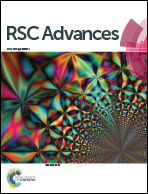A novel coumarin-based colorimetric and fluorescent probe for detecting increasing concentrations of Hg2+in vitro and in vivo†
Abstract
Mercury has complex biological toxicity and can cause a variety of physiological diseases and even death, so it is of great importance to develop novel strategies for detecting trace mercury in environmental and biological samples. In this work, we designed a new coumarin-based colorimetric and fluorescent probe CNS, which could be obtained from inexpensive starting materials with high overall yield in three steps. Probe CNS could selectively respond to Hg2+ with obvious color and fluorescence changes, and the presence of other metal ions had no effect on the fluorescence changes. Probe CNS also exhibited high sensitivity against Hg2+, with a detection limit as low as 2.78 × 10−8 M. More importantly, the behavioral tracks of zebrafish had no obvious changes upon treatment with 10 μM probe CNS, thus indicating its low toxicity. The probe showed potential application value and was successfully used for detecting Hg2+ in a test strip, HeLa cells and living zebrafish larvae.



 Please wait while we load your content...
Please wait while we load your content...